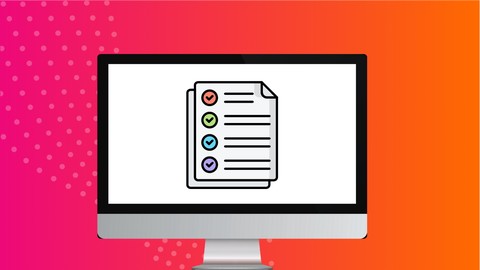
Complete IT Requirements and Requirement Engineering Course
Complete IT Requirements and Requirement Engineering Course, available at $54.99, has an average rating of 4.78, with 74 lectures, based on 18 reviews, and has 3194 subscribers.
You will learn about Basics of IT Requirement's and Requirement Engineering How to gather the IT Project Requirement's effectively Techniques and Tools for Requirement Engineering Requirement Engineering in Software Engineering, where it fits Everything about Requirement Engineering This course is ideal for individuals who are Aspiring Software Business Analyst people or People working in the software teams or Software Developers ,Lead , senior software engineering , managers ,technical lead, Project Lead It is particularly useful for Aspiring Software Business Analyst people or People working in the software teams or Software Developers ,Lead , senior software engineering , managers ,technical lead, Project Lead.
Enroll now: Complete IT Requirements and Requirement Engineering Course
Summary
Title: Complete IT Requirements and Requirement Engineering Course
Price: $54.99
Average Rating: 4.78
Number of Lectures: 74
Number of Published Lectures: 74
Number of Curriculum Items: 74
Number of Published Curriculum Objects: 74
Original Price: $19.99
Quality Status: approved
Status: Live
What You Will Learn
- Basics of IT Requirement's and Requirement Engineering
- How to gather the IT Project Requirement's effectively
- Techniques and Tools for Requirement Engineering
- Requirement Engineering in Software Engineering, where it fits
- Everything about Requirement Engineering
Who Should Attend
- Aspiring Software Business Analyst people
- People working in the software teams
- Software Developers ,Lead , senior software engineering , managers ,technical lead, Project Lead
Target Audiences
- Aspiring Software Business Analyst people
- People working in the software teams
- Software Developers ,Lead , senior software engineering , managers ,technical lead, Project Lead
Welcome to this course on IT Requirments- Requirement Engineering Course
This is the first-ever comprehensive IT Requirments- Requirement Engineering coursethat covers almost everything that anyone aspiring to learn and progress in the Software field can take up and become as proficient as someone with nearly 10+ years of experience. This course is the gist of my entire decades of experience crafted in 3+ hours of content. Whatever I learned during my career concerning the real-world IT Requirment Engineering I have included in this course. No boasting at all, Look at the course curriculum you will get the idea. In these 14 + Hours we are going to learn all the below concepts from scratch with a Real-life Case Study
All these things we will learn via the Real Life examples and case studies. All of the above things are covered in just over 3+ hoursof high-quality content. This is equivalent to a book with more than a thousand pages! in a very clear and concise manner doesn’t waste a single minute of your precious time!
You’re not going to get this information in One Place Anywhere over the Web.
Here is the course content in brief
Introduction
-
Overview of Requirement Engineering in IT
-
Importance of SEO in Course Descriptions
SECTION 1: Types of Requirements
-
Business Requirements
-
Definition and Examples
-
-
External Interface Requirements
-
Importance in System Integration
-
-
User Requirements
-
Gathering User Needs and Expectations
-
-
System Requirements
-
Technical Specifications and Constraints
-
-
Performance Requirements
-
Ensuring System Efficiency and Effectiveness
-
-
Regulatory Requirements
-
Compliance with Laws and Standards
-
-
Functional Requirements
-
Core Functions and Features
-
-
Non-Functional Requirements
-
Usability, Reliability, and Scalability
-
-
Levels of Requirements
-
High-Level vs. Detailed Requirements
-
-
Product Requirement vs. Project Requirements
-
Differences and Interconnections
-
SECTION 2: Introduction to Requirements Elicitation
-
Understanding Stakeholders and their Importance
-
Identifying and Engaging Stakeholders
-
-
Techniques for Eliciting Requirements
-
Surveys, Questionnaires, and Interviews
-
-
Observation Method in Requirements Collection
-
Benefits of Direct Observation
-
-
Prototyping and Mock-ups for Requirement Clarification
-
Visualizing Requirements
-
-
Joint Application Development (JAD) Sessions
-
Collaborative Requirement Gathering
-
-
Brainstorming for Requirement Discovery
-
Generating Innovative Ideas
-
-
Document Analysis in Requirements Elicitation
-
Reviewing Existing Documents
-
-
Use Cases and Scenarios
-
Defining User Interactions
-
-
User Stories
-
Capturing User Needs in Agile Projects
-
SECTION 3: Requirements Analysis and Specification
-
Techniques for Analyzing and Specifying Requirements
-
Breaking Down and Detailing Requirements
-
-
Functional and Non-Functional Requirements
-
Distinguishing Between Types
-
-
Requirements Modeling
-
Visual Representations of Requirements
-
-
Requirement Documentation
-
Creating Clear and Concise Documents
-
-
Requirements Traceability
-
Linking Requirements to Artifacts
-
-
Requirement Traceability Matrix
-
Tracking Requirements Throughout the Project
-
-
Requirements Prioritization
-
Determining Importance and Urgency
-
-
Best Practices and Challenges of Requirements Analysis
-
Tips and Common Pitfalls
-
SECTION 4: Requirements Validation and Verification
-
Techniques for Validating and Verifying Requirements
-
Ensuring Accuracy and Completeness
-
-
Requirements Inspection and Review
-
Formal and Informal Reviews
-
-
Test Case Development and Requirements-based Testing
-
Aligning Tests with Requirements
-
SECTION 5: Requirements Management
-
Requirements Version Control
-
Managing Changes and Versions
-
-
Defining a Version Identification Scheme
-
Creating a System for Tracking Versions
-
-
Tracking Individual Requirement Versions
-
Monitoring Changes Over Time
-
-
Tracking Versions of Requirement Sets
-
Managing Sets of Requirements
-
-
Requirement Baseline
-
Establishing an Approved Set of Requirements
-
-
Managing Requirements in Agile Projects
-
Adapting Requirements in Agile Environments
-
-
Change Control or Change Management Process
-
Handling Changes to Requirements
-
-
Change Control Policy
-
Defining Rules for Changes
-
-
Change Management Process Flow
-
Steps for Managing Changes
-
-
Change Request Lifecycle
-
Stages of a Change Request
-
-
Roles and Responsibilities in the Change Management Process
-
Defining Who Does What
-
-
Effect of Change on Project Resources
-
Assessing Impact on Time, Budget, and Scope
-
-
Requirement Status Tracking
-
Monitoring Progress and Status
-
-
Requirements Tracing
-
Ensuring Consistency and Completeness
-
-
Requirement Attributes to Track
-
Key Attributes to Monitor
-
-
Requirement Attribute List
-
Detailed List of Attributes
-
Conclusion
-
Recap of Key Points
-
Importance of Thorough Requirement Engineering
FAQs
-
What is the difference between functional and non-functional requirements?
-
How do you prioritize requirements in a project?
-
What is a requirement traceability matrix and why is it important?
-
How can stakeholders be effectively engaged in the requirements process?
-
What are the challenges of managing requirements in agile projects?
Downloadable resource
PREREQUISITES
There is no such Prerequisite for this course anybody who has an interest in learning the Software development process can take up this course. We will learn everything from scratch in this course.
30-DAY FULL MONEY-BACK GUARANTEE
This course comes with a 30-day full money-back guarantee. Take the course, watch every lecture, and do the exercises, and if you are not happy for any reason, contact Udemy for a full refund within the first 30 days of your enrolment. All your money back, no questions asked.
ABOUT YOUR INSTRUCTOR
Hi! My name is Yogesh Dahake! I’m a passionate Lead Software engineer with a decade of experience and I’ve taught over a thousand people about software development and Coding via my course and YouTube channel.
My goal is to enable people not just to learn but in an Optimal, efficient, and effective way and Generate that Spark of learning. That’s why my courses are simple, pragmatic, and free of clutter
So, what are you waiting for? Don’t waste your time jumping from one tutorial to another. Enroll in the course Acquire the LIFE Changing Skill in just 14 hours
Who this course is for:
1. People who are starting their careers in the software industry.
2. People who are students of Software Engineering.
3. People who are already working in the software company.
4. Developer, Lead, Technical Architect, Tester anybody who is directly or indirectly involved in the process of software development
5. People who want to develop quality software
6. Aspring Business analyst guys
On a higher note,
Anybody who has an interest in Software, From Students to Teachers, From People who are about to start their careers to Professionals in the software industry.
Course Curriculum
Chapter 1: About Course
Lecture 1: Introduction – What is this Course about
Lecture 2: Why to Learn IT Requirements Engineering and why this course
Lecture 3: How to take up this course
Chapter 2: SDLC Software Development Life Cycle Basics
Lecture 1: Introduction
Lecture 2: What is Software Development
Lecture 3: Overview of SDLC Software Development Life Cycle
Lecture 4: Importance of Requirement Engineering in SDLC
Lecture 5: Waterfall vs Agile
Lecture 6: Concept : Waterfall Model
Lecture 7: Concept : Agile Model
Chapter 3: Basics of Requirements Engineering
Lecture 1: Introduction
Lecture 2: What is Requirements
Lecture 3: What is Engineering
Lecture 4: Why Defining Requirements are so much Important for Software Success
Lecture 5: Signs of NOT Having Clear Project Requirement's
Lecture 6: Benefits of Clear Software Project Requirements
Lecture 7: Overview of Requirment Engineering Process
Lecture 8: Properties of Clear Software Requirements
Chapter 4: Types of Requirements
Lecture 1: Introduction
Lecture 2: Business Requirments
Lecture 3: External Interface Requirments
Lecture 4: User Requirments
Lecture 5: System Requirement
Lecture 6: Performance Requirments
Lecture 7: Regulatory Requirements
Lecture 8: Functional Requirements
Lecture 9: Non Functional Requirements
Lecture 10: Product Vs Project Requirments
Chapter 5: Requirements Elicitation
Lecture 1: Introduction
Lecture 2: What is Requirement Elicitation | Introduction to Requirement Elicitation
Lecture 3: Understanding Stakeholders and Their Importance in Requirement Elicitation
Lecture 4: Techniques of Requirement Elicitation
Lecture 5: Conducting Interviews for Requirement Elicitation
Lecture 6: Surveys and Questionnaires for Requirement Engineering
Lecture 7: Observation Method for Requirement Engineering
Lecture 8: Joint Application Development (JAD) Sessions
Lecture 9: Document Analysis in Requirements Elicitation
Lecture 10: Use Cases and Scenarios
Lecture 11: Concept – Use Stories in Agile
Lecture 12: Brainstorming for Requirement Discovery
Lecture 13: Use Case Diagram and Use Case Table ADD EXAMPLE Here
Lecture 14: Requirements Workshop
Lecture 15: Challenges and Best Practices in Requirements Elicitation
Chapter 6: Requirement Analysis and Specification
Lecture 1: Introduction
Lecture 2: Introduction to Requirements Analysis and Specification
Lecture 3: Techniques of Requirement Analysis
Lecture 4: Requirements Traceability
Lecture 5: Example of Requirement Traceability Matrix
Lecture 6: Applying Kano Prioritization to Online banking application
Lecture 7: Requirements Prioritization
Lecture 8: Best Practices and Common Challenges
Chapter 7: Requirements Validation and Verification
Lecture 1: Introduction
Lecture 2: Techniques for Validating and Verifying Requirements
Lecture 3: Requirements Inspection and Review
Lecture 4: Test Case Development and Requirements-based Testing
Chapter 8: Requirement Management
Lecture 1: Introduction
Lecture 2: Requirements Version Control
Lecture 3: Defining a Version Identification Scheme
Lecture 4: Tracking Individual Requirement Versions
Lecture 5: Requirement Baseline
Lecture 6: Managing Requirements in Agile Project
Lecture 7: Change Control or Change Management Process
Lecture 8: Change Control Policy
Lecture 9: Change Management Process Flow
Lecture 10: Change Request Lifecycle
Lecture 11: Roles and Responsibilities in the Change Management Process
Lecture 12: Effect or Impact of Changes on Project
Lecture 13: Requirement Status Tracking
Lecture 14: Requirements Attributes to Track
Lecture 15: List of Requirement Attributes for reference
Chapter 9: Requirement Engineering Tools
Lecture 1: Requirements Engineering Tools Or IT Requirement Tools
Lecture 2: Resource : Software Requirement Specification Template for Waterfall Model
Lecture 3: Resource : Software Design Prototyping Modelling Diagrams
Chapter 10: Conclusion
Lecture 1: Course Wrap Up
Instructors
-

Yogesh Dahake
Lead Software Developer
Rating Distribution
- 1 stars: 0 votes
- 2 stars: 1 votes
- 3 stars: 0 votes
- 4 stars: 2 votes
- 5 stars: 15 votes
Frequently Asked Questions
How long do I have access to the course materials?
You can view and review the lecture materials indefinitely, like an on-demand channel.
Can I take my courses with me wherever I go?
Definitely! If you have an internet connection, courses on Udemy are available on any device at any time. If you don’t have an internet connection, some instructors also let their students download course lectures. That’s up to the instructor though, so make sure you get on their good side!
You may also like
- Digital Marketing Foundation Course
- Google Shopping Ads Digital Marketing Course
- Multi Cloud Infrastructure for beginners
- Master Lead Generation: Grow Subscribers & Sales with Popups
- Complete Copywriting System : write to sell with ease
- Product Positioning Masterclass: Unlock Market Traction
- How to Promote Your Webinar and Get More Attendees?
- Digital Marketing Courses
- Create music with Artificial Intelligence in this new market
- Create CONVERTING UGC Content So Brands Will Pay You More
- Podcast: The top 8 ways to monetize by Podcasting
- TikTok Marketing Mastery: Learn to Grow & Go Viral
- Free Digital Marketing Basics Course in Hindi
- MailChimp Free Mailing Lists: MailChimp Email Marketing
- Automate Digital Marketing & Social Media with Generative AI
- Google Ads MasterClass – All Advanced Features
- Online Course Creator: Create & Sell Online Courses Today!
- Introduction to SEO – Basic Principles of SEO
- Affiliate Marketing For Beginners: Go From Novice To Pro
- Effective Website Planning Made Simple




















